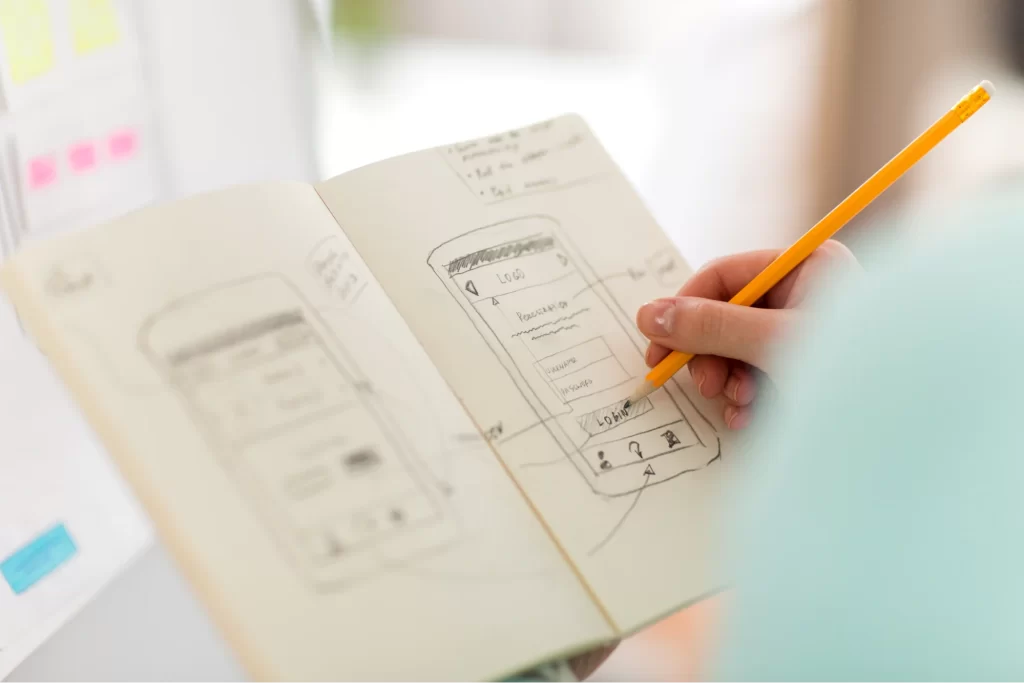Design thinking is a revolutionary approach to innovation and designing experiences. Read on to discover our comprehensive list of must-read design thinking books, which will equip you with everything you need to know about this important approach.
Design thinking approaches and processes have garnered far-reaching popularity in today’s design landscape. This has been the result of renowned researchers advocating their benefits and long-lasting impact, and several studies widely documenting the powerful impact design thinking can have on innovation and problem-solving.
But, what is it that contributes to the growing popularity of design thinking? And how can you learn more about the approach? This article intends to answer these questions and many more, by taking you on a walkthrough of design thinking books that discuss everything there is to know about this field.
Contents:
18 Must-read Design Thinking Books
- The Design Thinking Playbook by Michael Lewrick
- The Design of Everyday Things by Donald A. Norman
- Designing Experiences by James Robert Rossman and Mathew D. Duerden
- Emotional Design by Donald Norman
- Creative Confidence by David Kelley and Tom Kelley
- Change By Design by Tim Brown
- Don’t Make Me Think Revisited by Steve Krug
- Design Thinking: Understanding How Designers Think and Work by Nigel Cross
- The Designing for Growth Field Book by Jeanne Liedtka, Tim Ogilvie and Rachel Bronzenske
- This is Service Design Doing by Marc Stickdorn, Markus Hormess and Adam Lawrence
- Human-Centered Design Toolkit by IDEO
- Universal Principles of Design by Jill Butler, Kritina Holden and William Lidwell
- Service Design by Andy Polaine, Ben Reason and Lavrans Lovlie
- 100 Things Every Designer Needs to Know About People by Susan Weinschenk
- Rethinking Users by Benjamin J. Chesluk and Michael Youngblood
- How Design Makes Us Think by Sean Adams
- The Design of Business by Roger Martin
- Things We Could Design by Ronald Wakkary
Curious to know more about these amazing books? Let’s dive right in with no further ado!
18 Must-read Design Thinking Books
1. The Design Thinking Playbook by Michael Lewrick
The Design Thinking Playbook by Michael Lewrick is an insightful and practical guide on the principles of design thinking.The book offers a comprehensive overview of the design thinking process, providing step-by-step instructions and real-world examples to help readers apply the methodology effectively.
Why you should read this book
This is an excellent read if you are looking for actionable insights for the practical implementation of design thinking principles. The book’s user-friendly approach focuses on clear instructions and can be helpful regardless of whether or not you are from a design background.
2. The Design of Everyday Things by Donald A. Norman
Known for his contribution to the UI UX design field, Don Norman has been a pioneer in implementing design thinking in digital design. The Design of Everyday Things is one of his highly recommended design books that explores the concept of usability in everyday objects like doors, light switches, telephones, etc. The book primarily focuses on the idea that when users struggle with a product or interface, it’s often a design problem, not a user problem. Norman emphasises the need for user-centred design, clear feedback, and intuitive interfaces to make products more usable.
Why you should read this book
The Design of Everyday Things is a valuable book that offers an in-depth introduction to design and design thinking. Read this if you are a designer, engineer, or just interested in understanding how good design can make everyday things more user-friendly.
In case you’d like to know more about UX UI Design, an area of digital design that heavily utilises the principles of design thinking, here is a complete guide to get you started.

3. Designing Experiences by James Robert Rossman and Mathew D. Duerden
Designing Experiences is a versatile book that offers a comprehensive introduction to the field of experience design. Written as a practical toolkit, this book by Rossman and Duerden strives to acquaint readers with five types of experiences, while also providing a design framework that incorporates elements of design thinking.
Why you should read this book
Consider reading Designing Experiences if you are looking to know about real examples of the various design thinking tools and ideas that have helped designers enhance the overall user experience. Whether you are a beginner or a professional designer, the book’s straightforward and practical approach makes it a good read for everyone.
4. Emotional Design by Donald Norman
Don Norman’s Emotional Design is a thought-provoking read that explores the role of emotions in guiding user behaviour and ways designers can leverage them to create impactful designs. The book highlights the impact of emotions on user satisfaction and provides valuable principles to create products and experiences that people not only find useful but also genuinely enjoy and connect with on an emotional level.
Why you should read this book
Emotional Design is yet another excellent book by Norman that underscores the importance of designing for both form and function. Definitely read this book if you struggle to connect with the customer and understand their unsaid needs and why these are essential elements of a successful design.
5. Creative Confidence: Unleashing the Creative Potential Within Us All by David Kelley and Tom Kelley
True to its name, Creative Confidence explores the idea that everyone has the capacity for creative thinking. David and Tom Kelley cite real-world examples and case studies from their work at IDEO and the Stanford d.school to demonstrate how creativity and innovation have led to groundbreaking solutions.
Why you should read this book
If you struggle with creativity or fear of failure, this might be an excellent book to gain confidence in your skills. David Kelley, the founder of IDEO is largely credited for bringing design thinking into mainstream applications, and through this book, he offers practical tools and techniques that can help you boost your confidence, overcome the fear of failure, and unlock your creative potential.

6. Change By Design by Tim Brown
Offering a detailed overview of the design thinking framework, Change By Design demonstrates how design thinking can be applied not only to physical products but also to services, processes, and systems. The book introduces users to case studies and real-world examples to explain concepts like human-centred design and empathy.
Why you should read this book
This book comes from Tim Brown, who was credited with coining the term “design thinking” in the early 1960s. But if that’s not enough, it might help to know that the book includes case studies and practical exercises that could help you build a knowledge base, while providing a great starting point for inculcating empathy into the user experience design process.
7. Don’t Make Me Think Revisited by Steve Krug
As the name suggests, Don’t Make Me Think Revisited is the updated edition of the original web usability book Don’t Make Me Think. In this edition, Krug dives deep into the evolving landscape of website design and user interfaces and addresses key topics like challenges posed by mobile devices and responsive design, how to adapt and optimise websites for different platforms, and the importance of usability testing.
Why you should read this book
If you are a web developer and/or web designer, this is one of the most highly recommended books for you on this list. It provides straightforward insight into the changing digital landscape, alongside practical guidance. As a bonus, the “Laws of Usability” covered in the book also serve as a foundation for enhancing user website experience.
8. Design Thinking: Understanding How Designers Think and Work by Nigel Cross
A research-oriented theoretical publication, Design Thinking by Nigel Cross explores the complex nature of design thinking and offers insights into the thought processes and methodologies employed by designers. Not only does Cross dissect the common creative and problem-solving methods, but also draws in design thinking concepts from various disciplines.
Why you should read this book
If you are a researcher, teacher or student looking for a book that features unique content and offers a fresh perspective into design thinking practices, this is the one to go for. In this publication, Cross also highlights the iterative nature of design, with a focus on prototyping and testing as essential tools for refining ideas.
9. The Designing for Growth Field Book: A Step-by-Step Project Guide by Jeanne Liedtka, Tim Ogilvie and Rachel Brozenske
Particularly helpful for business owners and entrepreneurs, Designing for Growth includes practical tools, templates, and exercises to achieve meaningful results. Liedtka, Ogilvie and Brozenske also provide relatable examples and case studies to demonstrate the impact of design thinking in driving business growth, identifying growth opportunities, developing innovative solutions, and implementing them in a customer-friendly way.
Why you should read this book
If you’ve been on the lookout for a design thinking book that offers actionable strategies for achieving business success, Designing for Growth is what you need. This book provides a step-by-step framework for applying design thinking and could be a valuable resource for scaling business initiatives.

10. This is Service Design Doing by Marc Stickdorn, Markus Hormess, and Adam Lawrence
Suitable for learners of all levels, This is Service Design Doing builds on the principles of design thinking and focuses on how to apply them to the design of services. The book offers a practical toolkit and outlines a set of methods that can be used to improve the quality of interaction between service providers and customers through journey mapping, persona development, and ideation techniques.
Why you should read this book
This is Service Design Doing is an excellent resource if you are associated with the service industry and are seeking to understand and implement design thinking in the field. The book draws case studies from various industries along with practical guidance on comprehensive tools that can help designers create user-centric service experiences for diverse industries.
11. Human-Centered Design Toolkit by IDEO
A product of the International Development Enterprise (IDE), the Human-Centred Design Toolkit was developed to enable non-profit organisations to effectively meet their goals. As an actionable guide, the book offers innovative business solutions rooted in design thinking principles that cater to the unique problems of impoverished communities.
Why you should read this book
The Human Centered Design Toolkit can be a valuable resource if you work with NGOs and social enterprises and are seeking to address complex problems in a financially sustainable way. Since this is a toolkit, you can especially benefit from hands-on guidance through exercises on building listening skills, running workshops, and implementing ideas.
12. Universal Principles of Design by Jill Butler, Kritina Holden, and William Lidwell
Considered to be an essential reference for designers, Universal Principles of Design is primarily popular for its cross-disciplinary approach to elaborating on design principles. However, in offering essential practical guidance to design, the book also makes an excellent read for design thinking purposes as it covers topics like usability, perception and psychology.
Why you should read this book
This is a must-read for anyone looking for actionable insights to improve their design, regardless of the design field they work in. The book incorporates rich illustrations to elaborate on each concept, making it extremely easy to understand how fundamental principles can be put into practice across various design disciplines, including graphic design, product design, architecture, and more.

13. Service Design: From Insight to Implementation by Andy Polaine, Ben Reason, and Lavrans Lovlie
Going beyond the traditional understanding of user experience, Service Design takes into consideration the role a well-designed service can play in the overall user experience. The book, hence, comprises practical guidance on designing services for innovation and intervention for common issues in areas like transport, sustainability, government, finance, communications and healthcare.
Why you should read this book
The book offers an excellent overview of the evolving field of service design. Whether you are a web designer, user experience designer, graphic designer, product designer, or business strategist, the cross-disciplinary approach of this book can help you successfully implement design thinking in various service verticals.
14. 100 Things Every Designer Needs to Know About People by Susan Weinschenk
100 Things Every Designer Needs to Know About People is a practical guide that bases its information on research and behavioural science concepts. The book talks about the influence of cognitive factors like attention, memory, vision, and motivation on users and how these can be leveraged to design intuitive digital products.
Why you should read this book
This book can be of particular aid if you are a UX designer striving to design effective digital products. Each concept covered in this book is backed by research and credible sources and provides knowledge that can also come in handy for those regularly engaging with various collaterals like prints, websites, applications, and products.
15. Rethinking Users by Benjamin J. Chesluk and Michael Youngblood
User needs and motivations can be an integral aspect of designing human-centric products. Highlighting over 15 user profiles, Rethinking User outlines various user archetypes with details on the nature of their experience and guidance on making the right strategic decisions for each archetype. In doing so, the book also expands on the understanding of human experience and could be an excellent tool for empathising with a target audience when designing any service or product.
Why you should read this book
If you have ever struggled with understanding user needs and segmentation, this book could serve as a great reference point. Rethinking Users offers excellent insights into how user segmentation is key to creating a design that caters to the players in different ecosystems.

16. How Design Makes Us Think: And Feel and Do Things by Sean Adams
A collection of over a hundred examples across graphic design, product design, industrial design, and architecture, How Design Makes Us Think illustrates the power of design in communicating key messages. The book also takes into account the sociological, psychological and historical context of design to explore how and why users respond to certain visual cues.
Why you should read this book
The practical nature of the book makes it a great reference point for understanding design and how it can be leveraged to draw in new audiences. Read this if you are keen on a walkthrough of different themes like humour, seduction, anger, love etc to understand the impact of design on communication.
17. The Design of Business by Roger Martin
The Design of Business by Roger Martin is an insightful and thought-provoking book that delves into the intersection of design thinking and business strategy. In an attempt to highlight the far-reaching impact of design, Martin challenges traditional business models and argues that a focus on customer-centric design can drive innovation and success.
Why you should read this book
Yet another classic in the field of design thinking, The Design of Business offers real-world examples and case studies that illustrate how design thinking can be applied in various industries. Although targeted at business leaders, designers, and entrepreneurs, consider reading this if you are interested in problem-solving and strategy development, no matter the field you work in.
18. Things We Could Design: For More Than Human-Centered Worlds by Ronald Wakkary
Contrary to the mainstream perspective, Things We Could Design takes an antithetical stand on human-centric design. Wakkary in his book emphasises the need to rethink design from a non-human perspective and focus on design that caters to needs transcending direct human requirements. The book draws heavy inspiration from philosophy, design theory, and several other design works.
Why you should read this book
Things We Could Design is one of the best options if you want to look at human-centred design from a perspective that challenges the mainstream narrative. The book is best suited for design researchers, scholars, and environmentalists, who wish to learn more about design and how it can be used to answer other non-human problems.

Learn More About Design Thinking
There is no doubt that design thinking has emerged as an essential part of designing user-friendly and accessible products. The approach not only provides a framework and structure for actualising design initiatives but has also opened gates for innovation through interdisciplinary collaboration rooted in empathy.
Adopting a design thinking approach can, in other words, help foster innovation, deeply understand user needs, and provide a structured and adaptable approach to problem-solving. While books and research publications remain one of the best means to learn more about design thinking, here are some other resources you can refer to.
- Podcasts – The Design Thinking 101 hosted by Dawan Stanford, Design Mind Frogcast, Design Driven Hosted by J Cornelius
- YouTube Channels – High Resolution, Google Design, AJ&Smart, Case Studio playlist from Dalham Learning
- TED Talks – Design Thinking, Speed up Innovation with Design Thinking, Design thinking – what, how, why, when, Adopting Systems Thinking and Design Thinking to solve daily problems
- Case Studies – Redesigning Employment Pass Application in Singapore, Early Approaches: The US Tax Forms Simplification Project, Developing an App for Type II Diabetes, UberEats Design Thinking Case Study
- Short Courses on Design Thinking and/or UX UI Design – Design Thinking and Innovation, Foundations in Design Thinking, UX & Design Thinking Quick Start, UX UI Design Course.
Next Steps
We hope our comprehensive list of the best design thinking books could be of assistance in your design journey. We also recommend going through the Balanced Community Project by AND learners to get a hang of how design thinking is implemented in practice.
In case you think you need further assistance, here are some of our resources you can consider:
- Watch this session by Shiva Viswanathan, Design Head of Ogilvy Pennywise, and Naman Singh, Product Experience Designer at RED.
- Talk to a course advisor to discuss how you can transform your career with one of our courses.
- Pursue our UX UI Design courses – all courses are taught through live, interactive classes by industry experts, and some even offer a Job Guarantee.
- Take advantage of the scholarship and funding options that come with our courses to overcome any financial hurdle on the path of your career transformation.
Note: All information and/or data from external sources is believed to be accurate as of the date of publication.









